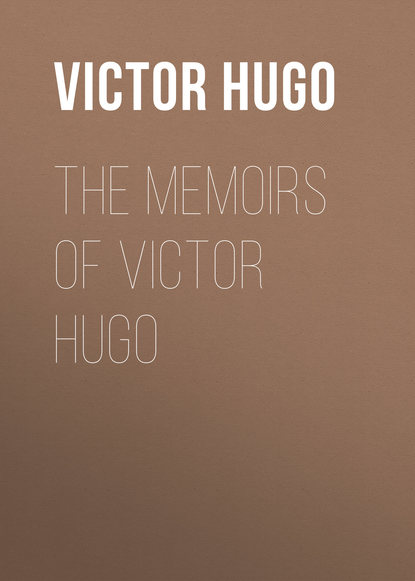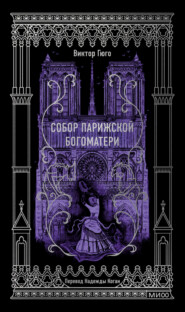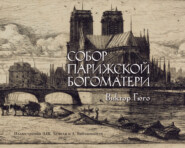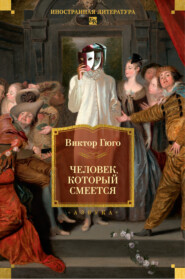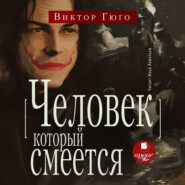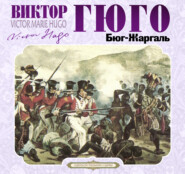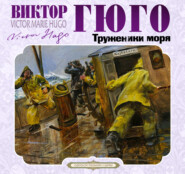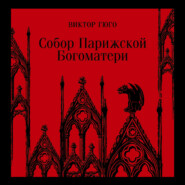По всем вопросам обращайтесь на: info@litportal.ru
(©) 2003-2024.
✖
The Memoirs of Victor Hugo
Настройки чтения
Размер шрифта
Высота строк
Поля
The men condemned to death in the Bréa affair are confined in the fort at Vanves. There are five of them: Nourry, a poor child of seventeen whose father and mother died insane, type of the gamin of Paris that revolutions make a hero and riots a murderer; Daix, blind of one eye, lame, and with only one arm, a bon pauvre of the Bicetre Hospital, who underwent the operation of trepanning three years ago, and who has a little daughter eight years old whom he adores; Lahr, nicknamed the Fireman, whose wife was confined the day after his condemnation, giving life at the moment she received death; Chopart, a bookseller’s assistant, who has been mixed up in some rather discreditable pranks of youth; and finally Vappreaux junior, who pleaded an alibi and who, if the four others are to be believed, was not at the Barrière de Fontainebleau at all during the three days of June.
These hapless wights are confined in a big casemate of the fort. Their condemnation has crushed them and turned them towards God. In the casemate are five camp beds and five rush-bottomed chairs; to this lugubrious furniture of the dungeon an altar has been added. It was erected at the end of the casemate opposite the door and below the venthole through which daylight penetrates. On the altar is only a plaster statue of the Virgin enveloped in lace. There are no tapers, it being feared that the prisoners might set fire to the door with the straw of their mattresses. They pray and work. As Nourry has not been confirmed and wishes to be before he dies, Chopart is teaching him the catechism.
Beside the altar is a board laid upon two trestles. This board, which is full of bullet holes, was the target of the fort. It has been turned into a dining-table, a cruel, thoughtless act, for it is a continual reminder to the prisoners of their approaching death.
A few days ago an anonymous letter reached them. This letter advised them to stamp upon the flagstone in the centre of the casemate, which, it was affirmed, covered the orifice of a well communicating with old subterranean passages of the Abbey of Vanves that extended to Châtillon. All they had to do was to raise the flagstone and they could escape that very night.
They did as the letter directed. The stone, it was found, did emit a hollow sound as though it covered an opening. But either because the police had been informed of the letter, or for some other reason, a stricter watch than ever has been kept upon them from that moment and they have been unable to profit by the advice.
The gaolers and priests do not leave them for a minute either by day or by night. Guardians of the body cheek by jowl with guardians of the soul. Sorry human justice!
The execution of the condemned men in the Bréa affair was a blunder. It was the reappearance of the scaffold. The people had kicked over the guillotine. The bourgeoisie raised it again. A fatal mistake.
President Louis Bonaparte was inclined to be merciful. The revision and cassation could easily have been delayed. The Archbishop of Paris, M. Sibour, successor of a victim, had begged for their lives. But the stereotyped phrases prevailed. The country must be reassured. Order must be reconstructed, legality rebuilt, confidence re-erected! And society at that time was still reduced to employing lopped heads as building material. The Council of State, such as it then was, consulted under the terms of the Constitution, rendered an opinion in favour of the execution. M. Cresson, counsel for Daix and Lahr, waited upon the President. He was an emotional and eloquent young man. He pleaded for these men, for the wives who were not yet widows, for the children who were not yet orphans, and while speaking he wept.
Louis Bonaparte listened to him in silence, then took his hands, but merely remarked: “I am most unhappy!”
In the evening of the same day – it was on the Thursday – the Council of Ministers met. The discussion was long and animated. Only one minister opposed recourse to the scaffold. He was supported by Louis Napoleon. The discussion lasted until 10 o’clock. But the majority prevailed, and before the Cabinet separated Odilon Barrot, the Minister of Justice, signed the order for the execution of three of the condemned men, Daix, Lahr and Chopart. The sentences of Nourry and Vappreaux, junior, were commuted to penal servitude for life.
The execution was fixed for the next morning, Friday.
The Chancellor’s office immediately transmitted the order to the Prefect of Police, who had to act in concert with the military authorities, the sentence having been imposed by a court-martial.
The prefect sent for the executioner. But the executioner could not be found. He had vacated his house in the Rue des Marais Saint Martin in February under the impression that, like the guillotine, he had been deposed, and no one knew what had become of him.
Considerable time was lost in tracing him to his new residence, and when they got there he was out. The executioner was at the Opera. He had gone to see “The Devil’s Violin.”
It was near midnight, and in the absence of the executioner the execution had to be postponed for one day.
During the interval Representative Larabit, whom Chopart had befriended at the barricade of the barriers, was notified and was able to see the President. The President signed Chopart’s pardon.
The day after the execution the Prefect of Police summoned the executioner and reproved him for his absence.
“Well,” said Samson, “I was passing along the street when I saw a big yellow poster announcing The Devil’s Violin. ‘Hello!’ said I to myself, ‘that must be a queer piece,’ and I went to see it.”
Thus a playbill saved a man’s head.
There were some horrible details.
On Friday night, while those who formerly were called les maitres des basses oeuvres[14 - The executioner in France is officially styled l’executeur des hautes-oeuvres.] were erecting the scaffold at the Barrière de Fontainebleau, the rapporteur of the court-martial, accompanied by the clerk of the court, repaired to the Fort of Vanves.
Daix and Lahr, who were to die, were sleeping. They were in casemate No. 13 with Nourry and Chopart. There was a delay. It was found that there were no ropes with which to bind the condemned men. The latter were allowed to sleep on. At 5 o’clock in the morning the executioner’s assistants arrived with everything that was necessary.
Then the casemate was entered. The four men awoke. To Nourry and Chopart the officials said: “Get out of here!” They understood, and, joyful and terror-stricken, fled into the adjoining casement. Daix and Lahr, however, did not understand. They sat up and gazed about them with wild, frightened eyes. The executioner and his assistants fell upon them and bound them. No one spoke a word. The condemned men began to realise what it all meant and uttered terrible cries. “If we had not bound them,” said the executioner, “they would have devoured us!”
Then Lahr collapsed and began to pray while the decree for their execution was read to them.
Daix continued to struggle, sobbing, and roaring with horror. These men who had killed so freely were afraid to die.
Daix shouted: “Help! Help!” appealed to the soldiers, adjured them, cursed them, pleaded to them in the name of General Bréa.
“Shut up!” growled a sergeant. “You are a coward!”
The execution was performed with much ceremony. Let this fact be noted: the first time the guillotine dared to show itself after February an army was furnished to guard it. Twenty-five thousand men, infantry and cavalry, surrounded the scaffold. Two generals were in command. Seven guns commanded the streets which converged to the circus of the Barrière de Fontainebleau.
Daix was executed first. When his head had fallen and his body was unstrapped, the trunk, from which a stream of blood was pouring, fell upon the scaffold between the swing-board and the basket.
The executioners were nervous and excited. A man of the people remarked: “Everybody is losing his head on that guillotine, including the executioner!”
In the faubourgs, which the last elections to the National Assembly had so excited, the names of popular candidates could still be seen chalked upon the walls. Louis Bonaparte was one of the candidates. His name appeared on these open-air bulletins, as they may be termed, in company with the names of Raspail and Barbès. The day after the execution Louis Napoleon’s name wherever it was to be seen had a red smear across it. A silent protest, a reproach and a menace. The finger of the people pending the finger of God.
III. THE SUICIDE OF ANTONIN MOYNE. April, 1849
Antonin Moyne, prior to February, 1848, was a maker of little figures and statuettes for the trade.
Little figures and statuettes! That is what we had come to. Trade had supplanted the State. How empty is history, how poor is art; inasmuch as there are no more big figures there are no more statues.
Antonin Moyne made rather a poor living out of his work. He had, however, been able to give his son Paul a good education and had got him into the Ecole Polytechnique. Towards 1847 the art-work business being already bad, he had added to his little figures portraits in pastel. With a statuette here, and a portrait there, he managed to get along.
After February the art-work business came to a complete standstill. The manufacturer who wanted a model for a candlestick or a clock, and the bourgeois who wanted a portrait, failed him. What was to be done? Antonin Moyne struggled on as best he could, used his old clothes, lived upon beans and potatoes, sold his knick-knacks to bric-à-brac dealers, pawned first his watch, then his silverware.
He lived in a little apartment in the Rue de Boursault, at No. 8, I think, at the corner of the Rue Labruyère.
The little apartment gradually became bare.
After June, Antonin Moyne solicited an order of the Government. The matter dragged along for six months. Three or four Cabinets succeeded each other and Louis Bonaparte had time to be nominated President. At length M. Leon Faucher gave Antonin Moyne an order for a bust, upon which the statuary would be able to make 600 francs. But he was informed that, the State funds being low, the bust would not be paid for until it was finished.
Distress came and hope went.
Antonin Moyne said one day to his wife, who was still young, having been married to him when she was only fifteen years old: “I will kill myself.”
The next day his wife found a loaded pistol under a piece of furniture. She took it and hid it. It appears that Antonin Moyne found it again.
His reason no doubt began to give way. He always carried a bludgeon and razor about with him. One day he said to his wife: “It is easy to kill one’s self with blows of a hammer.”
On one occasion he rose and opened the window with such violence that his wife rushed forward and threw her arms round him.
“What are you going to do?” she demanded.
“Just get a breath of air! And you, what do you want?”
“I am only embracing you,” she answered.
On March 18, 1849, a Sunday, I think it was, his wife said to him:
“I am going to church. Will you come with me?”
He was religious, and his wife, with loving watchfulness, remained with him as much as possible.
These hapless wights are confined in a big casemate of the fort. Their condemnation has crushed them and turned them towards God. In the casemate are five camp beds and five rush-bottomed chairs; to this lugubrious furniture of the dungeon an altar has been added. It was erected at the end of the casemate opposite the door and below the venthole through which daylight penetrates. On the altar is only a plaster statue of the Virgin enveloped in lace. There are no tapers, it being feared that the prisoners might set fire to the door with the straw of their mattresses. They pray and work. As Nourry has not been confirmed and wishes to be before he dies, Chopart is teaching him the catechism.
Beside the altar is a board laid upon two trestles. This board, which is full of bullet holes, was the target of the fort. It has been turned into a dining-table, a cruel, thoughtless act, for it is a continual reminder to the prisoners of their approaching death.
A few days ago an anonymous letter reached them. This letter advised them to stamp upon the flagstone in the centre of the casemate, which, it was affirmed, covered the orifice of a well communicating with old subterranean passages of the Abbey of Vanves that extended to Châtillon. All they had to do was to raise the flagstone and they could escape that very night.
They did as the letter directed. The stone, it was found, did emit a hollow sound as though it covered an opening. But either because the police had been informed of the letter, or for some other reason, a stricter watch than ever has been kept upon them from that moment and they have been unable to profit by the advice.
The gaolers and priests do not leave them for a minute either by day or by night. Guardians of the body cheek by jowl with guardians of the soul. Sorry human justice!
The execution of the condemned men in the Bréa affair was a blunder. It was the reappearance of the scaffold. The people had kicked over the guillotine. The bourgeoisie raised it again. A fatal mistake.
President Louis Bonaparte was inclined to be merciful. The revision and cassation could easily have been delayed. The Archbishop of Paris, M. Sibour, successor of a victim, had begged for their lives. But the stereotyped phrases prevailed. The country must be reassured. Order must be reconstructed, legality rebuilt, confidence re-erected! And society at that time was still reduced to employing lopped heads as building material. The Council of State, such as it then was, consulted under the terms of the Constitution, rendered an opinion in favour of the execution. M. Cresson, counsel for Daix and Lahr, waited upon the President. He was an emotional and eloquent young man. He pleaded for these men, for the wives who were not yet widows, for the children who were not yet orphans, and while speaking he wept.
Louis Bonaparte listened to him in silence, then took his hands, but merely remarked: “I am most unhappy!”
In the evening of the same day – it was on the Thursday – the Council of Ministers met. The discussion was long and animated. Only one minister opposed recourse to the scaffold. He was supported by Louis Napoleon. The discussion lasted until 10 o’clock. But the majority prevailed, and before the Cabinet separated Odilon Barrot, the Minister of Justice, signed the order for the execution of three of the condemned men, Daix, Lahr and Chopart. The sentences of Nourry and Vappreaux, junior, were commuted to penal servitude for life.
The execution was fixed for the next morning, Friday.
The Chancellor’s office immediately transmitted the order to the Prefect of Police, who had to act in concert with the military authorities, the sentence having been imposed by a court-martial.
The prefect sent for the executioner. But the executioner could not be found. He had vacated his house in the Rue des Marais Saint Martin in February under the impression that, like the guillotine, he had been deposed, and no one knew what had become of him.
Considerable time was lost in tracing him to his new residence, and when they got there he was out. The executioner was at the Opera. He had gone to see “The Devil’s Violin.”
It was near midnight, and in the absence of the executioner the execution had to be postponed for one day.
During the interval Representative Larabit, whom Chopart had befriended at the barricade of the barriers, was notified and was able to see the President. The President signed Chopart’s pardon.
The day after the execution the Prefect of Police summoned the executioner and reproved him for his absence.
“Well,” said Samson, “I was passing along the street when I saw a big yellow poster announcing The Devil’s Violin. ‘Hello!’ said I to myself, ‘that must be a queer piece,’ and I went to see it.”
Thus a playbill saved a man’s head.
There were some horrible details.
On Friday night, while those who formerly were called les maitres des basses oeuvres[14 - The executioner in France is officially styled l’executeur des hautes-oeuvres.] were erecting the scaffold at the Barrière de Fontainebleau, the rapporteur of the court-martial, accompanied by the clerk of the court, repaired to the Fort of Vanves.
Daix and Lahr, who were to die, were sleeping. They were in casemate No. 13 with Nourry and Chopart. There was a delay. It was found that there were no ropes with which to bind the condemned men. The latter were allowed to sleep on. At 5 o’clock in the morning the executioner’s assistants arrived with everything that was necessary.
Then the casemate was entered. The four men awoke. To Nourry and Chopart the officials said: “Get out of here!” They understood, and, joyful and terror-stricken, fled into the adjoining casement. Daix and Lahr, however, did not understand. They sat up and gazed about them with wild, frightened eyes. The executioner and his assistants fell upon them and bound them. No one spoke a word. The condemned men began to realise what it all meant and uttered terrible cries. “If we had not bound them,” said the executioner, “they would have devoured us!”
Then Lahr collapsed and began to pray while the decree for their execution was read to them.
Daix continued to struggle, sobbing, and roaring with horror. These men who had killed so freely were afraid to die.
Daix shouted: “Help! Help!” appealed to the soldiers, adjured them, cursed them, pleaded to them in the name of General Bréa.
“Shut up!” growled a sergeant. “You are a coward!”
The execution was performed with much ceremony. Let this fact be noted: the first time the guillotine dared to show itself after February an army was furnished to guard it. Twenty-five thousand men, infantry and cavalry, surrounded the scaffold. Two generals were in command. Seven guns commanded the streets which converged to the circus of the Barrière de Fontainebleau.
Daix was executed first. When his head had fallen and his body was unstrapped, the trunk, from which a stream of blood was pouring, fell upon the scaffold between the swing-board and the basket.
The executioners were nervous and excited. A man of the people remarked: “Everybody is losing his head on that guillotine, including the executioner!”
In the faubourgs, which the last elections to the National Assembly had so excited, the names of popular candidates could still be seen chalked upon the walls. Louis Bonaparte was one of the candidates. His name appeared on these open-air bulletins, as they may be termed, in company with the names of Raspail and Barbès. The day after the execution Louis Napoleon’s name wherever it was to be seen had a red smear across it. A silent protest, a reproach and a menace. The finger of the people pending the finger of God.
III. THE SUICIDE OF ANTONIN MOYNE. April, 1849
Antonin Moyne, prior to February, 1848, was a maker of little figures and statuettes for the trade.
Little figures and statuettes! That is what we had come to. Trade had supplanted the State. How empty is history, how poor is art; inasmuch as there are no more big figures there are no more statues.
Antonin Moyne made rather a poor living out of his work. He had, however, been able to give his son Paul a good education and had got him into the Ecole Polytechnique. Towards 1847 the art-work business being already bad, he had added to his little figures portraits in pastel. With a statuette here, and a portrait there, he managed to get along.
After February the art-work business came to a complete standstill. The manufacturer who wanted a model for a candlestick or a clock, and the bourgeois who wanted a portrait, failed him. What was to be done? Antonin Moyne struggled on as best he could, used his old clothes, lived upon beans and potatoes, sold his knick-knacks to bric-à-brac dealers, pawned first his watch, then his silverware.
He lived in a little apartment in the Rue de Boursault, at No. 8, I think, at the corner of the Rue Labruyère.
The little apartment gradually became bare.
After June, Antonin Moyne solicited an order of the Government. The matter dragged along for six months. Three or four Cabinets succeeded each other and Louis Bonaparte had time to be nominated President. At length M. Leon Faucher gave Antonin Moyne an order for a bust, upon which the statuary would be able to make 600 francs. But he was informed that, the State funds being low, the bust would not be paid for until it was finished.
Distress came and hope went.
Antonin Moyne said one day to his wife, who was still young, having been married to him when she was only fifteen years old: “I will kill myself.”
The next day his wife found a loaded pistol under a piece of furniture. She took it and hid it. It appears that Antonin Moyne found it again.
His reason no doubt began to give way. He always carried a bludgeon and razor about with him. One day he said to his wife: “It is easy to kill one’s self with blows of a hammer.”
On one occasion he rose and opened the window with such violence that his wife rushed forward and threw her arms round him.
“What are you going to do?” she demanded.
“Just get a breath of air! And you, what do you want?”
“I am only embracing you,” she answered.
On March 18, 1849, a Sunday, I think it was, his wife said to him:
“I am going to church. Will you come with me?”
He was religious, and his wife, with loving watchfulness, remained with him as much as possible.





